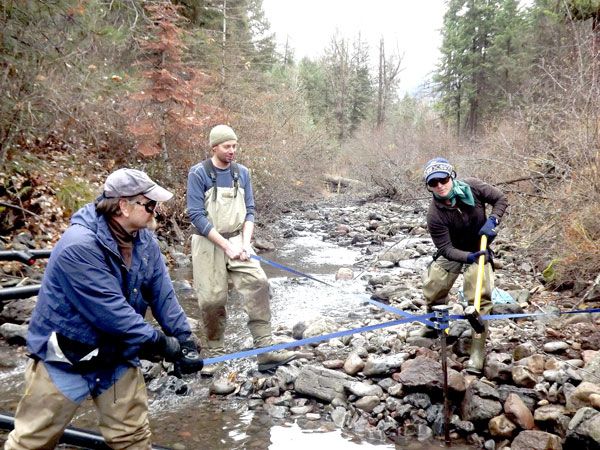Counting Fish
Published 8:09 am Friday, November 15, 2013

- Jim Harbeck and Eric Showdell of the Nez Perce Tribe steady a bar as Montana Pagano pounds in a duck bill into the bed of Crazy Man Creek. Each passive integrated transponder needs eight duck bills to stabilize it. (KATY NESBITT/WesCom News Service)
Nez Perce Fisheries expands
its research into Crazy Man Creekby insterting a new transponder
IMNAHA -When it comes to fish recovery, being counted matters. This month Nez Perce Tribe Fisheries added one more instrument to the Imnaha River basin to see how many steelhead are making it to the upper tributaries to spawn in the spring.
Last week, the Tribe installed its seventh Passive Integrated Transponder array in the basin on Crazy Man Creek. The array is not only the farthest upstream, but one that presented more logistical issues than the others, said Jim Harbeck, Joseph Field Office supervisor.
An array detects tagged adult fish as they swim upstream to spawning grounds. A signal is emitted from the fish’s tag and relayed to a computer. From there, the data is sent via satellite to a database easily accessed from the comfort of the Tribe’s Joseph office.
Last winter, the Joseph office purchased a two-man pontoon fishing boat, in part, with the Crazy Man project in mind, said Neal Espinosa, a fisheries biologist for the Tribe. The boat was river-tested last summer and this fall it had its seats removed, tethered to a line crossing the river and used to ferry everything from 200 pound propane tanks to tools, equipment and even pots of coffee and boxes of donuts.
“The remote location has no access to electricity, so the propane tanks are used to power the system,” said
Espinosa.
It takes 1.5 to 2 hours to get to the work site, so the biologists need to come prepared with plenty of drinking water and a hefty lunch to support days of swinging sledge hammers and digging trenches to install the array.
Espinosa said Bonneville Power Administration funds the Tribe’s research. That money helps his crew maintain fish weirs at Gumboot and Mahogany creeks in the spring, spawning ground surveys for steelhead and chinook and data monitoring along the Upper Imnaha.
Fish don’t read maps or know property boundaries. Since the mouth of Crazy Man is on private land, access had to be granted for the project. Harbeck said he is very thankful for the opportunity to use the land as one of the Tribe’s field resources. “The landowner and manager have been very gracious.”
Harbeck said the Tribe chose to install an array instead of a weir on Crazy Man Creek because the Imnaha would be difficult to cross during spring run-off when the steelhead are headed for the upper tributaries. “When the steelhead are up here to spawn, the Imnaha will be raging,” said Harbeck.
Last spring Espinosa said his crew did its first spawning ground survey on Crazy Man. “We walked 3.3 kilometers and found 13 redds (steelhead nests) andndash; that’s about 3.9 redds per kilometer,” said Espinosa.
He said that translates into more than 20 adults that made it upstream, but expects there were even more redds than were counted. This spring, he said the crew will extend its spawning ground survey farther upstream and he will begin looking for data from the array in late March.
Not only does the array tell the biologists how many tagged adult steelhead swim upstream, but the time they pass is recorded, as well. “They give good read ranges and have really good efficiency on adult fish,” said Espinosa.
He said the system not only sends information on tagged fish, but sends files to show if it is running properly or not.
Harbeck said for the Tribe, the Crazy Man installation if just part of the overall monitoring effort for wild steelhead, a species listed as endangered in 1996. “So little is known about the true status and trend of this listed population.”
Keeping track of and endangered species’ numbers is one of the measures biologists use to assess whether it is recovering or not. Harbeck said besides getting a better handle on steelhead numbers on the Upper Imnaha, a minor objective is to analyze possible genetic differences between them and the lower river spawners.
“We will look to see if they are genetically related to steelhead that spawn at Cow, Horse and Lightning creeks,” said Harbeck.
Harbeck said if the populations are isolated, they are not exchanging genes. “This PIT tag array will help us establish abundance and differences or similarities with other Snake River Steelhead.”
Biologists will also look into whether the Upper Imnaha fish have similar life histories and characteristics as the lower river spawners.
Besides where it spawns, part of a steelhead’s life history is the choice it makes to remain in a creek as a juvenile or to rear in the river before it “smolts” or morphs into a sea-bound fish.
Most steelhead die after they spawn, but some, known as kelts, swim head back to the ocean. “A kelt is hedging its bet in terms of reproduction. If the first go around is a failure, it gets another shot,” said Harbeck.
Harbeck said the PIT tag technology has been around since the 1980’s. “So much of what we know about fish is through the arrays. They have advanced fisheries biology by leaps and bounds.”





